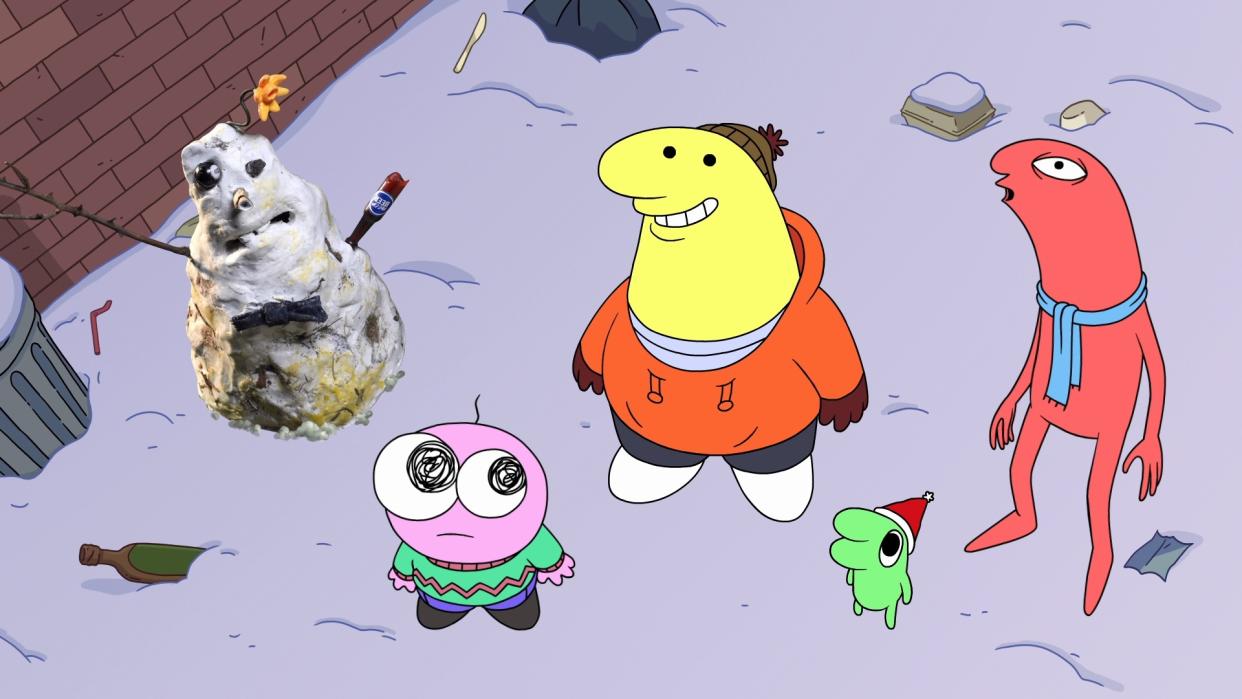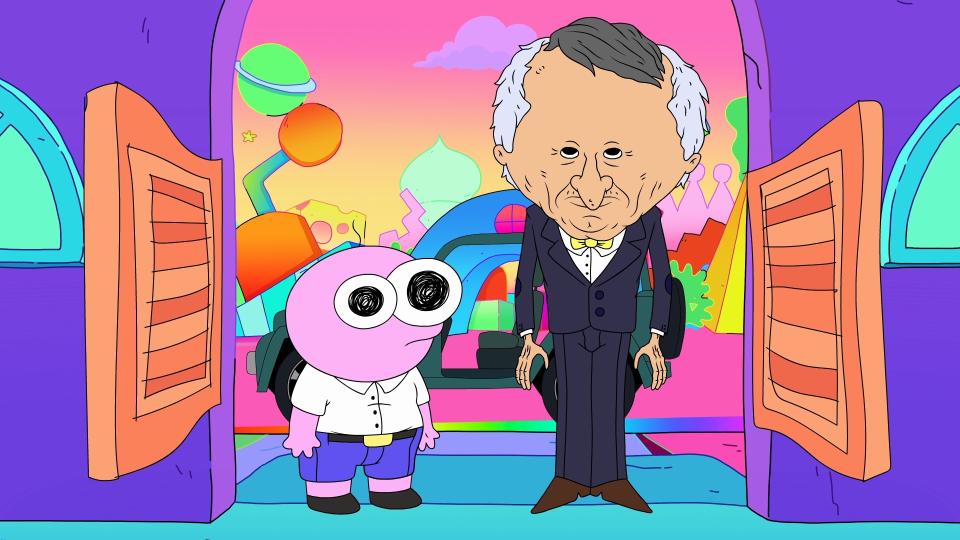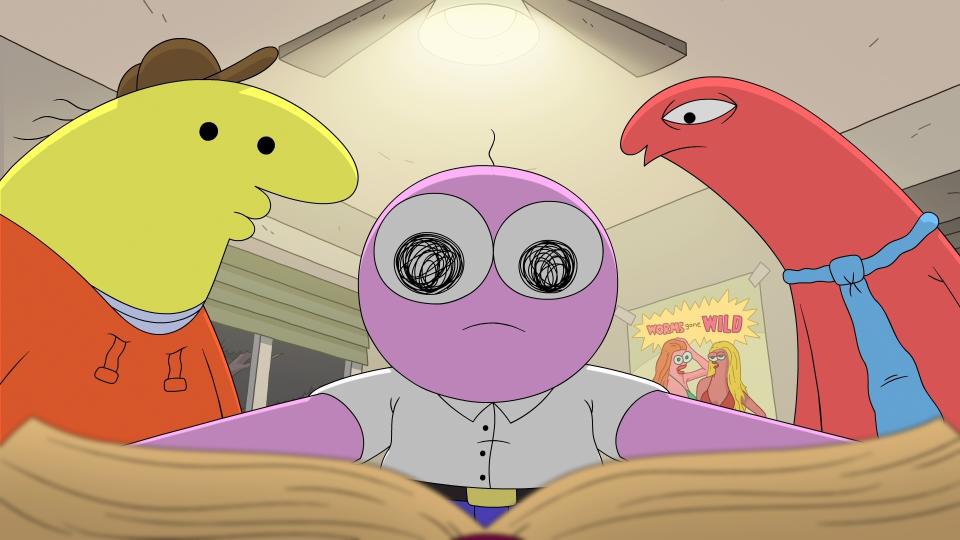No One Takes Stupidity as Seriously as the ‘Smiling Friends’ Creators

- Oops!Something went wrong.Please try again later.
- Oops!Something went wrong.Please try again later.
- Oops!Something went wrong.Please try again later.
“There’s one important thing to know about ‘Smiling Friends,’” the show’s co-creator Zach Hadel said during a recent Zoom interview with IndieWire. “It’s not smart.”
It was a reoccurring sentiment. Over the course of our conversation, Hadel and co-creator Michael Cusack repeatedly called their show “dumb,” “stupid,” “not smart,” and, in one colorful tangent, suggested that society would be better off if they were barred from producing television and sent to work in underground mines. But their humility masks a deep commitment to silliness that might be the secret to making “Smiling Friends” feel so damn refreshing.
More from IndieWire
Why 'Blood of Zeus' Is More Interested in Riffing on Greek Mythology
'Bridgerton' Showrunner Teases Season 3: 'We Wanted to Really Earn the Sex Scene'
The animated series, which follows an eclectic group of nonprofit employees who are tasked with making sad people smile (and are legally obligated to do anything a sad customer asks until they smile), was a massive hit in alternative comedy circles when it premiered on Adult Swim in 2022. The show embodied the mixture of unapologetic weirdness and handcrafted animation that powered so many of the cable brand’s biggest hits in the late ’90s and early 2000s. It quickly cemented its status as one of the network’s crown jewels with a brilliant travel special “The Smiling Friends Go to Brazil” and a renewal for Season 2.
After a two year wait and a viral April Fool’s Day prank, the highly anticipated second season finally arrives this weekend. Most creators are eager to hype up the brilliance of their own work in the run-up to its release, but Hadel and Cusack were quick to downplay my suggestions that “Smiling Friends” is anything resembling high art.
“People love over-analyzing media and going ‘Oh, it’s actually genius because…’” Hadel said. “To us, ‘Smiling Friends’ is literally just a callback of like ‘90s ‘Beavis and Butt-Head,’ ‘South Park,’ ‘SpongeBob.’ ‘Looney Tunes’ if you even want to go there. Not in terms of style, but in the sense that it’s pure, stupid, comedy. It’s not complex, it’s not gonna change your life. It’s not supposed to! It’s just supposed to be stupid, funny, and that’s it.”

There’s certainly some truth to what Hadel says. At its core, “Smiling Friends” follows four critters who are more identifiable with colors and shapes than any specific species. Pim Pimling is a short pink circle, Charlie Dompler is a larger yellow blob, Glep is a miniature green wizard-like creature who speaks in gibberish, and Allan Red is an oblong red pessimist who seldom wears more than a blue necktie. The characters are equally at home traveling through fantasy realms and navigating mundane airport mix-ups throughout the 11 minute episodes as they seek to placate their employer, who is appropriately named Mr. Boss. The two-dimensional show frequently incorporates different animation styles as a way of bending its loose sense of reality even further, ensuring that fans never know what to expect when starting a new episode.
It’s a complex alchemical blend of whimsy that could easily go awry in less capable hands. But years of riffing about nonsense together prepared the creators for the challenge of bottling their zany worldview into concise TV episodes.
“The cool thing about ‘Smiling Friends,’ how it started is Zach and I would meet at a place called Harry’s Diner in Burbank, and we would just spitball for hours about the show before it even existed,” Cusack said. “We’d write a million ideas and notes down and do a bunch of drawings. So we had this big doc that we came up with years ago that we actually still go to now today to mine from.”
That Google doc features a cornucopia of “Smiling Friends” ideas, ranging from fleshed out lore to minimalistic bullet points (one episode this season was inspired by the note “Pim flies a fucking airplane”). While the show takes place in an anything-goes world of cartoon nonsense without many obvious parameters, jotting down their random thoughts has given the two partners an increasingly coherent sense of what is allowed to happen in the bizarre universe.

“We have ‘rules’ of what we know happens in the world. Like we know who was elected president in this fake world in 1960, but that’s never in the show. And that’s kind of by design,” Hadel said. “And that’s another reason we do the whole mixed media thing, is it lets us do whatever we want. We built it so that — I’m not even saying this would happen — but if we wanted to have an episode that’s all live action, we could. We could have a live action character, we could have a video game character, stop motion, we could do whatever we want. It’s designed to both have no rules at all, so that you could have a talking shrimp next to a pink guy next to a live action guy so it all makes sense, but also have some rules.”
I didn’t wake up that morning expecting to ask who won the 1960 presidential election in the “Smiling Friends” universe. But once Hadel broached the subject, it would have been journalistic malpractice not to dig deeper. Rather than laugh off my follow-up question, he asked me to wait a moment while he pulled up the legendary Google doc and found the presidential history section.
“I will explain to you that John F. Kennedy was the president,” Hadel said. “And that whole ordeal played out the same way.”
“But he didn’t get shot in ’63, did he?” Cusack interjected with dead seriousness. “I think he finished out his whole term.”
This sparked a sidebar conversation between the two men about the history of “Smiling Friends” electoral politics, but it wasn’t long before a closer study of the document put everyone back on the same page.
“We figured all the important presidents like Bill Clinton and Reagan were there, but they only had one term,” Hadel clarified, noting that the lack of second terms allowed them to add a crustacean president named Shrimpo Jones and an anonymous child president at various points without altering the timeline of U.S. history too severely.
“Shrimpo Jones was the president in 1976. But then there was also a boy genius who was elected once, and I think the population quickly regretted electing a child as president,” Hadel said. “But Shrimpo Jones replaces [Jimmy] Carter, and he’s in hospice right now. Someone is brushing his hair right now, but it’s a different guy from the peanut farmer.”
None of this had much bearing on Season 2 of “Smiling Friends,” and it could probably be argued that the conversation was a waste of everyone’s time. But it spoke to how serious these two men are about the art of making stupid television. In a comedy ecosystem that increasingly favors the two ends of the production value spectrum — online DIY content and flashy prestige shows — “Smiling Friends” stands out as a project that manages to split the difference. Each episode manages to cram a towering mountain of asininity into its 11 minute runtime, a feat that probably owes as much to their years of world-building as their background making 60 second YouTube shorts. They even fantasize about releasing all their lore someday in a companion book that mirrors J.R.R. Tolkien’s “Lord of the Rings” supplement “The Silmarillion.”
“At some point when we’re 90 years old, we want to put out a ‘Smile-arillion,’ as we call it with all the visual history,” Hadel said with a laugh. “Just crap that seven people would buy.”
If Hadel and Cusack are as serious about making people smile as their characters are professionally obligated to be, they might want to think about releasing that book a little sooner.
Season 2 of “Smiling Friends” premieres Sunday, May 12 at midnight on Adult Swim.
Best of IndieWire
The 13 Best Thrillers Streaming on Netflix in May, from 'Fair Play' to 'Emily the Criminal'
The Best Father and Son Films: 'The Tree of Life,' 'The Lion King,' and More
The 10 Best Teen Rebellion Films: 'Pump Up the Volume,' 'Heathers,' and More
Sign up for Indiewire's Newsletter. For the latest news, follow us on Facebook, Twitter, and Instagram.

